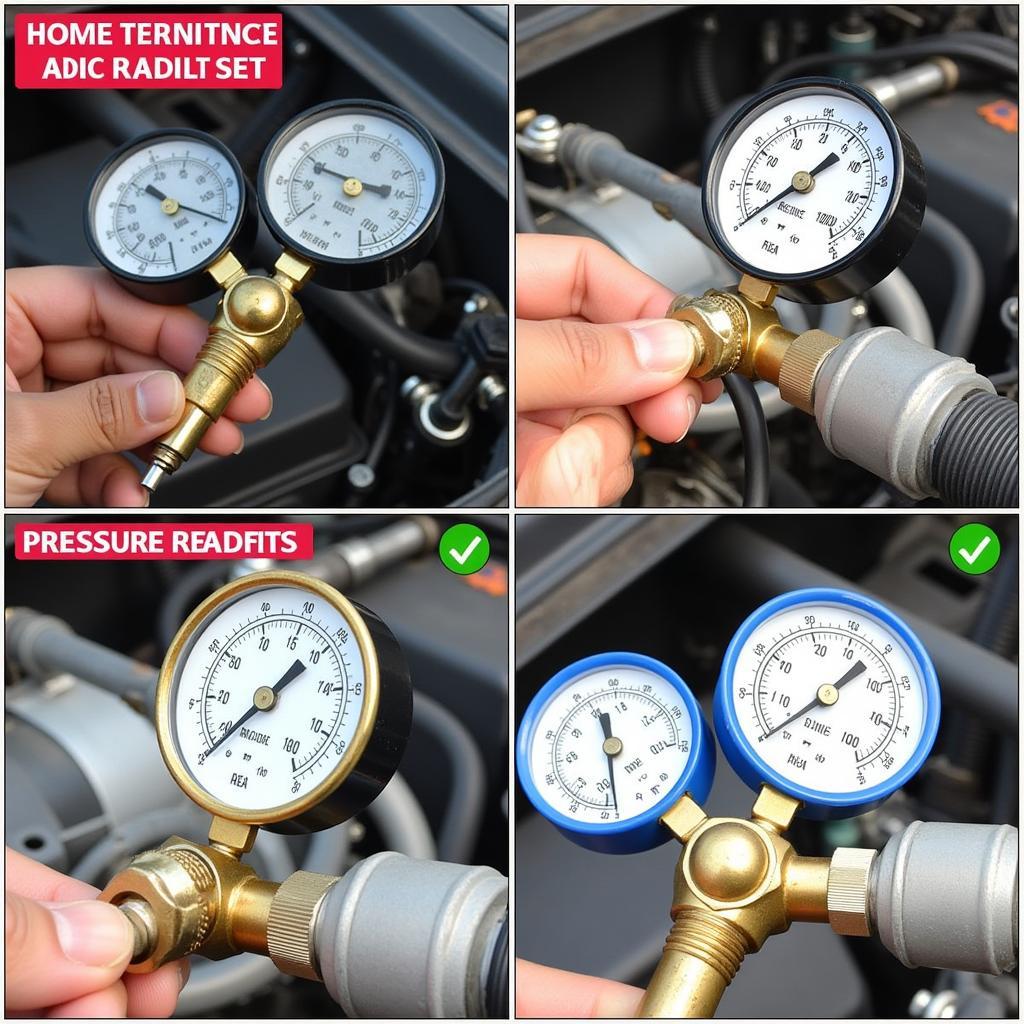Overfilling your car’s AC with freon can lead to a variety of problems, impacting performance and potentially causing damage. If you suspect you’ve added too much refrigerant, addressing it quickly is crucial. This guide will walk you through diagnosing and fixing an overcharged AC system.
Understanding the Risks of Overcharged AC
Adding too much freon, also known as refrigerant, isn’t a “more is better” situation. An overcharged system operates under abnormally high pressure, putting stress on various components. This can lead to compressor damage, reduced cooling efficiency, and even leaks. It’s crucial to understand the correct amount of refrigerant your system needs, which is typically specified in your car’s owner’s manual or on a sticker under the hood.
Identifying an Overcharged Car AC System
Several signs indicate you might have overfilled your AC. These include:
- Poor cooling performance: Ironically, too much refrigerant can actually reduce cooling efficiency.
- High-pressure readings: Using an AC pressure gauge set is the most definitive way to diagnose an overcharge.
- Unusual noises: Gurgling or hissing sounds from the AC system can suggest an issue.
- Compressor cycling on and off frequently: The compressor might turn on and off rapidly, struggling to regulate the high pressure.
If you notice these symptoms, it’s time to address the overfilling.
How to Fix Overfilling Freon: A Step-by-Step Guide
Fixing an overcharged AC system requires carefully releasing some of the excess refrigerant. This process should ideally be done by a certified technician with the proper equipment and knowledge of safe refrigerant handling practices. However, if you’re confident in your DIY skills and understand the risks involved, you can follow these steps:
- Gather your supplies: You’ll need an AC manifold gauge set, a refrigerant recovery machine (highly recommended), safety glasses, and gloves. Note: Releasing refrigerant into the atmosphere is illegal and harmful to the environment. A recovery machine is essential for responsible handling.
- Locate the AC service ports: These are typically located on the high and low-pressure lines of the AC system.
- Connect the manifold gauge set: Follow the instructions provided with your gauge set for proper connection to the service ports.
- Check the pressure readings: With the engine running and the AC on max, observe the pressure readings on the gauges. Compare these readings with the recommended pressures specified for your vehicle.
- Slowly release the refrigerant: If the pressure is high, slowly release refrigerant using the valve on the manifold gauge set, if you’re using a recovery machine, connect it and follow its instructions for refrigerant recovery.
- Monitor the pressure: Continuously monitor the pressure while releasing refrigerant, aiming for the recommended pressure range.
- Reconnect the system and test: Once the pressure is within the correct range, disconnect the gauges and test the AC system.
Preventing Overfilling in the Future
The best way to fix overfilling is to avoid it in the first place. Here are some tips:
- Consult your car’s manual: Always refer to your car’s manual for the correct refrigerant type and quantity.
- Use a scale when adding refrigerant: Accurately measure the refrigerant you’re adding using a scale to prevent overfilling.
- Consider professional help: If you’re unsure about any step of the process, it’s best to consult a qualified technician.
 Checking Car AC Pressure with Gauges
Checking Car AC Pressure with Gauges
“Overfilling is a common mistake, but a preventable one,” says John Davis, Senior Automotive Technician at Efficient Cooling Solutions. “A little precaution and understanding of your AC system can go a long way.”
Why Precise Refrigerant Levels Matter
Maintaining the correct refrigerant charge is essential for optimal AC performance. Too little refrigerant (undercharging) leads to weak cooling, while too much (overcharging) puts stress on the system and can cause damage. Finding the sweet spot ensures efficient cooling and prolongs the lifespan of your AC components. “Think of it like a recipe,” adds Davis, “too much or too little of any ingredient throws off the balance and the final product suffers.”
How to Fix Overfilling Freon in Car AC: FAQs
- What happens if I don’t fix an overcharged AC system? Ignoring an overcharged system can lead to compressor damage, leaks, and reduced cooling performance, requiring costly repairs.
- Can I add refrigerant myself? While it’s possible, handling refrigerant requires specialized equipment and knowledge. It’s best to consult a certified technician.
- How often should I have my AC system checked? It’s recommended to have your AC system inspected annually by a qualified technician.
In conclusion, fixing an overcharged car AC involves carefully releasing the excess refrigerant, preferably with a recovery machine. Understanding the signs of overcharging and following the correct procedure are crucial to avoid potential damage. For any assistance or if you’re unsure about any step, connect with us at AutoTipPro at +1 (641) 206-8880 or visit our office at 500 N St Mary’s St, San Antonio, TX 78205, United States. We’re here to help keep you cool!





Leave a Reply